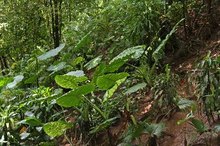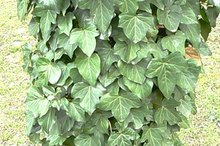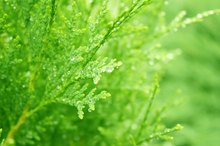Can You Die From Poison Oak?
You can, in theory, die from poison oak poisoning if you develop severe respiratory symptoms. However, poison oak is most noted for causing contact dermatitis that a medical professional can readily diagnosis and treat 2.
Poison Oak
Poison oak (Toxicodendron diversilobum) refers to the Western poison oak and Atlantic poison oak (Toxicodendron pubescens). The toxic plants have three glossy leaves. These plants are not true oaks, but part of the sumac family (Anacardia) 1. The leaves are red-green in spring, dark green in summer and red in autumn. The flowers are whitish-green and dangle in clusters. The seeds are green balls that in summer are white when they become ripe. All parts of these plants are dangerous.
- Poison oak (Toxicodendron diversilobum) refers to the Western poison oak and Atlantic poison oak (Toxicodendron pubescens).
- The flowers are whitish-green and dangle in clusters.
Urushiol
Causes of Red Bumps That Itch
Learn More
Urushiol is a toxic oil, an allergen, that is found in poison oak, poison sumac and poison ivy. It is not an immediate allergen, but one that takes sensitization and, usually, a second contact with poison oak to evidence a person's allergy.
Urushiol Delivery
According to the American Academy of Dermatology, people can come in contact with urushiol when they accidentally break leaves. Urushiol poisoning can also occur when someone touches clothes, tools or pets that have come into contact with poison oak. Respiratory contact can occur from pollen and from burning poison oak foliage.
Symptoms Of Urushiol Poisoning
Elephant Ear Skin Irritation and Treatment
Learn More
According to the Merck Manual, about 50 percent to 70 percent of the population is allergic to urushiol. The symptoms of urushiol poisoning, begin with itching and swelling. An inflammation of tiny pimples cover the skin. Blistering can occur with clear fluid exuding from the rash. Urushiol poison symptoms can last two to five weeks. According to Wildland Firefighter magazine, burning poison oak can cause respiratory symptoms such as blisters in the lungs, swelling of the lungs and coughing. Extreme irritation and swelling in the throat, sometimes closing the airway, has been noted. Seek immediate medical attention for both skin and respiratory conditions.
- According to the Merck Manual, about 50 percent to 70 percent of the population is allergic to urushiol.
- The symptoms of urushiol poisoning, begin with itching and swelling.
Poison Oak Poisoning Prevention
Wearing long sleeve shirts, long pants, gloves and a hat while gardening is essential to preventing poison oak dermatitis. Eye protection is also useful. Washing clothes and hands after poison oak contact is important. Never burn poison oak, poison ivy or sumac. The plant is dormant in winter and can be carefully removed in its resting phase. Always wear protective clothing while removing poison oak.
- Wearing long sleeve shirts, long pants, gloves and a hat while gardening is essential to preventing poison oak dermatitis.
- Washing clothes and hands after poison oak contact is important.
Related Articles
References
- Native Plants Of Montara Mountain: Sumac Family
- Merck Manuals: Contact Dermatitis
- American Osteopathic College of Dermatology: Poison Ivy Dermatitis
- Boston Children's Hospital. Poison Ivy, Poison Oak and Poison Sumac.
- American Academy of Dermatology. Poison Ivy, Oak, and Sumac: Who gets a rash and is it contagious?
- Prok L, McGovern T. Patient education: Poison ivy (Beyond the Basics). UpToDate. Updated March 25, 2019.
- U.S. Food and Drug Administration. Outsmarting Poison Ivy and Other Poisonous Plants. Updated August 6, 2016.
- Porter R. Poison Ivy, Poison Oak and Poison Sumac. National Capital Poison Center.
- Usatine RP, Riojas M. Diagnosis and management of contact dermatitis. Am Fam Physician. 2010;82(3):249-55.
- MedlinePlus. Bentoquatam Topical. Updated February 15, 2018.
- American Academy of Dermatology. (2018). Poison ivy, oak, and sumac. https://www.aad.org/public/diseases/itchy-skin/poison-ivy-oak-and-sumac
- Curtis G, Lewis AC. Treatment of severe poison ivy: a randomized, controlled trial of long versus short course oral prednisone. J Clin Med Res. 2014 Dec;6(6):429-34. doi: 10.14740/jocmr1855w.
- Habif TP. Clinical Dermatology: A Color Guide to Diagnosis and Therapy. Elsevier; 2016.
- U.S. Food and Drug Administration. (2016). Outsmarting Poison Ivy and Its Cousins. https://www.fda.gov/ForConsumers/ConsumerUpdates/ucm049342.htm
Resources
Writer Bio
Anne Cagle has been writing ever since she was a toddler who could scribble with crayons. Her first published article, at age 12, was in a teachers' newsletter. She was published in "Optical Prism" magazine and has worked as a reviewer for the Webby Awards. She holds a degree in English from the University of Oregon.









